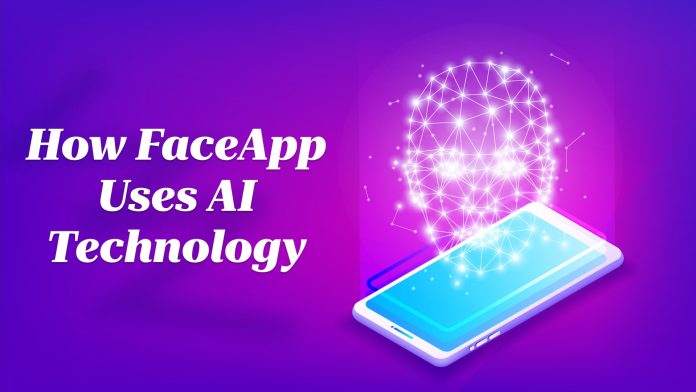Introduction
FaceApp has established itself as a leader in the quickly evolving field of digital applications, enthralling consumers with its AI-powered transforming powers. FaceApp uses cutting-edge AI technology to work in the background and transform how we interact with and manipulate photos.
Within this blog post, we will explore the captivating realm of how FaceApp uses AI to achieve its extraordinary facial transformations.
What is FaceApp?
FaceApp is a mobile application that uses artificial intelligence (AI) and has become quite popular because it can add various filters and effects to images of faces. Users are enticed to its features because they can change their gender, age, look younger or older, apply cosmetics, and more.
A notable aspect of FaceApp is its proficiency in creating realistic transformations, achieved through AI algorithms and intense learning technology. The app delivers entertaining and visually convincing results by analyzing and modifying facial features in a photo.
However, this surge in popularity has been accompanied by privacy concerns and apprehensions regarding the potential misuse of user data.
Available as a free download on the Apple App Store and Google Play for Android devices, FaceApp has garnered nearly 200,000 reviews on the App Store, boasting a commendable 4.7 rating.
While the app’s free version offers a variety of filters, some are available only through paid options. These filters encompass facial adjustments, smile enhancements, skin tone alterations, changes in hair color, and even gender transformations.
How Does AI Make FaceApp Popular?
Leveraging the power of artificial intelligence, FaceApp incorporates neural networks to enhance user experience through accessibility, simplicity, and impressive functionality. Neural networks within mobile applications serve the crucial roles of pattern recognition and forecasting, offering diverse benefits to businesses in telecommunications, operational management, and information quality detection.
FaceApp employs machine learning algorithms that introduce artificial modifications to original images based on user preferences to delve into the mechanics. This interactive and user-friendly approach has contributed to its popularity, as individuals enjoy engaging with the application’s enticing features.
In addition, the developers of FaceApp have adeptly implemented logic to identify, moderate, and present alternative images aligned with the chosen filters. Each filter operates in a distinct sense, exemplified by features like anti-ageing and ageing filters that discern skin tone and adjust wrinkles to create a visually convincing portrayal of a younger or older version of the user.
Despite its technologically advanced features, FaceApp has faced data privacy and security scrutiny. The following section will delve deeper into the concerns surrounding its safe usage.
How Did FaceApp Integrate AI?
FaceApp uses AI called neural networks to perform its facial transformations. Neural networks belong to a category of machine learning algorithms that draw inspiration from the architecture and operations of the human brain. In particular, FaceApp employs a neural network called a generative adversarial network (GAN).
Here’s a simplified overview of how FaceApp uses AI:
Training the Neural Network
FaceApp’s AI model is trained on a large dataset of facial images. These images may include examples of faces of different ages, genders, and expressions.
The neural network learns patterns and features from these training images, allowing it to understand the relationships between different facial characteristics.
Generative Adversarial Network
FaceApp utilizes a GAN consisting of two main components: a generator and a discriminator.
The generator creates new images by generating variations based on the learned patterns.
The discriminator evaluates these generated images and compares them to authentic photos from the training set.
The generator and discriminator are in a continual feedback loop, with the generator aiming to produce increasingly realistic images and the discriminator getting better at distinguishing between real and generated images.
Transformation Features
When a user applies a filter in FaceApp (e.g., making themselves look older), the app uses the trained neural network to identify and modify specific facial features.
The neural network adjusts the input image based on its learned understanding of how specific changes affect facial appearance.
Real-Time Processing
FaceApp performs these transformations on the user’s device in real-time, allowing for a quick and interactive experience.
Different Technologies Behind the FaceApp
In the years since FaceApp garnered attention, it has made notable advancements in image recognition by harnessing the power of deep learning technology. This sophisticated approach goes beyond the essential recognition in Snapchat filters, operating on a more advanced level.
Deep learning, considered the most advanced form of machine learning, is at the core of FaceApp’s image recognition capabilities. Through deep neural networks, the process involves feeding sample data—images of users, their friends, family, celebrities, and anyone who granted the app access to their camera rolls. Through this exposure to diverse data, the neural network learns intricate details of the human face.
In deep learning, the system’s accuracy improves with the quantity of sample data processed by the neural network. This continual refinement results in FaceApp’s ability to generate hyper-realistic transformations, such as the widely shared ‘old age’ photos seen across various social media platforms.
The Final Thought!
The demand for editing tools is rising in the era of a rising preference for audiovisual content on the internet. FaceApp, a seemingly secure and practical application, is gaining popularity rapidly, suggesting its potential to evolve into a billion-dollar corporation.
If you want to build an AI-enabled photo editing app like FaceApp, consider a dedicated mobile app development company like VLink as your partner. Ensure they stand out as a compelling option for developing an AI-powered face editor app like FaceApp.
Connect with their development team to discuss your concept. You will get a comprehensive consultation on the matter and an estimate of the costs involved in building a face editing app.
Empower Your Online Experience with Hide Expert VPN








